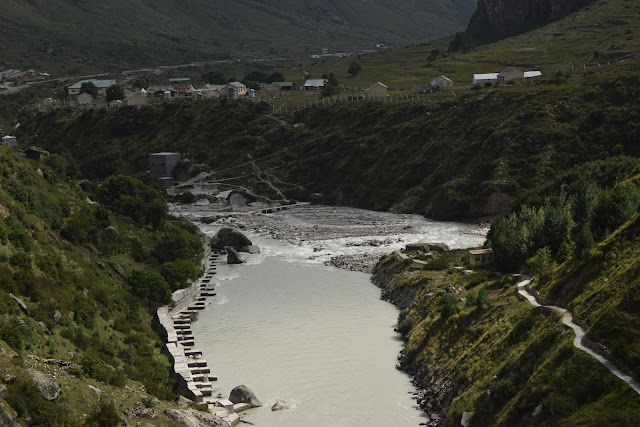Mana, the last
village
After Badri Vishal darshan,
we had a quick break-fast at an expensive joint overlooking the temple, Masala
Dosa at its worst! The small town was already alive with pilgrims and
sanyasis. Dogs were moving around
freely. Sanyasis were smoking cannabis squatting on a concrete platform at the
landing of the bridge over Ganga. Anybody was welcome. However, people were rather
disinterested.
By the time we reached Adwaita
Bhavan, Veena Sahasrabuddhe was diffusing through the air, her highs
poignant…. her lows gentle and sure, creating a mood of serenity. A desktop PC
at the office room was the source and I found no one there. A couple of minutes later, a tall, unfriendly
sanyasi barged in with his jada
(hair) like a blasted nebula, donning a designer cloak made of jute. Obviously
he had spent the previous night in the open. The desktop belonged to him with
its 76 GB of outstanding music. I asked him whether I could copy the music but
he didn’t utter a word. He must be in arya
maun (observing noble silence), I consoled myself. Later I gathered that he
was Ajit Chaitanya, a medical doctor working in Germany who quit his job to
become a sanyasi. He was a Keralite,
from Palakkad. Swami transferred 3 GB of music into my mobile memory card.
We started off to Mana,
the last village of India situated at the China/Tibet border. Sadly enough, one
of the rear wheels got punctured and we had to set it right. The belated start
did affect our planning, we couldn’t follow the Mahaprastana route of the Pandavas.
(The warrior-kings of the epic Mahabharata who after winning the war against
their cousins, got convinced that nothing really mattered). Mana was just three km away from
Badrinath. There was an arch welcoming the visitor to the village and one had
to park the vehicle outside. There were only walkways inside the village,
crisscrossing the whole place with tiny houses on both
sides. These hutments had a small
backyard where the villagers grew vegetables and potatoes.
Sunil Gala was waiting at the entrance offering his services
as Guide for Rs.300. Rajan asked him for Guide’s license and he was infuriated.
In fact he was from the village itself, pursuing an industrial training course
elsewhere. Young people who could roughly understand English had turned impromptu
guides. Sunil felt insulted for being asked about his credentials in his own
village by an outsider.
 |
| Nandu with Sunil |
According to Sunil, the entire Mana village was inhabited by the descendants of a Mongolian tribe
called Rongpa and there were 180
families of them in the village. The total population was around 600. They live
in Mana for six months, i.e., from May to October and when the snow-fall starts,
Rongpas make a bee-line to Chamoli, a beautiful village 100 km away.
They come back after six months when the Badrinath temple re-opens.
 |
| Vyasa Gufa |
We were climbing up a small mountain towards Vyasa Gufa (cave), from where we thought
we could see the China/Tibet border. That was not to be. From the cave, it was
a steep climb upwards. Dead –end! Unless you were trained in mountaineering,
getting at the top would be impossible. The border was 24 km away from the
place. Moreover, Indian Army had its
strong presence camped further up.
The gufa and
surroundings were well-kept, with no litters. The legend says Vyasa wrote the epic Mahabharata sitting
at this cave. He chose Lord Ganesha as his stenographer due to the elephant
headed god’s sharp intellect and ability to capture every utterance with his
elephantine ears.
Adjacent to Vyasa gufa,
there was a small tea-shop 3200 m above sea-level, made hodge-podge, declaring
to the rest of the world about its uniqueness. According to the sign-board, the
joint was the last Tea-shop of India. Immediately we thought of having tea, standing
at the entrance to get photographed! Later, we came to know that there were at
least three “last tea shop of India” situated at various dead-ends.
 |
| The last tea-shop of India |
We stretched ourselves under the trees. There was certain
stillness in the air. It was time to climb down.
We saw Ganesh gufa too,
much smaller in size where the writing part of the epic was done. While the Lord was at work, River Saraswati in a playful mood flooded and
snatched away the writing instrument! Undeterred, Ganesha broke one of his
tusks and continued with the assignment! Vyasa got immensely furious and cursed
the River to vanish from earth. Saraswati
became persona non grata.
 |
| River Saraswati at her source |
We did a site visit and checked her status. The origin was
still intact. You would be spellbound seeing her gushing out from a cave in
full force. You were standing on “Bheem pul “, the single-rock-bridge believed
to be made by one of the Pandava
brothers, Bheema in the Mahaprastana (journey to heaven after
renouncing everything) route. You could even reach out and touch Saraswati from the bridge. Strangely
enough, water at the downstream side was surprisingly calm. Saraswati had become a non-entity and
flowed quietly ahead for three hundred odd meters to join Alakananda at the sangam
(confluence).
 |
| Saraswati at sangam- View from Bhim Pul |
As per our micro-plan, we’ve had to tread five km further up
(along the Mahaprastana route) to
take bath at Vasudhara waterfalls.
The water line, is so thin that it always fluctuated according to the
wind-force. Trekking 25 km up, there exists the abode of legendary Himalayan
Sanyasis, said to be living perennially. They have ashrams by the banks of Sadopanth
Lake. The enigmatic Saint Babaji,
believed to be 400 years old, is said to be living there!
We decided to return, anyway!
**********************

No comments:
Post a Comment
Post a Comment